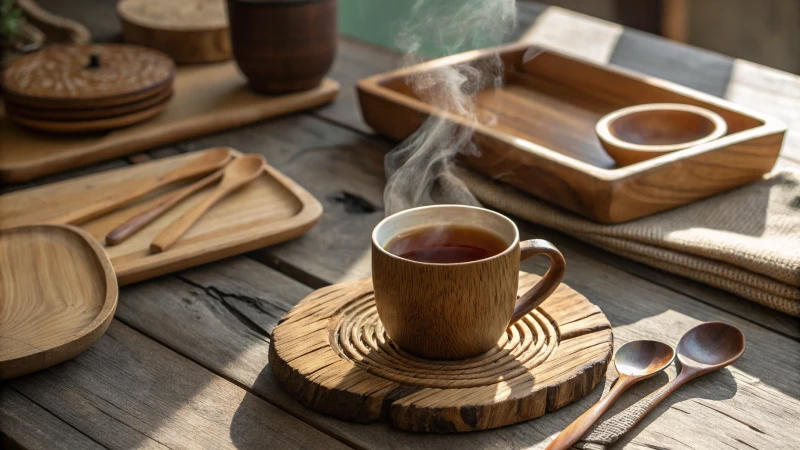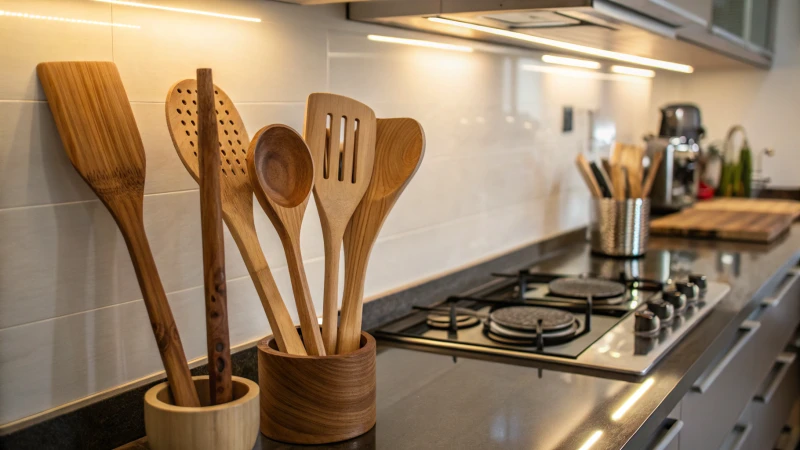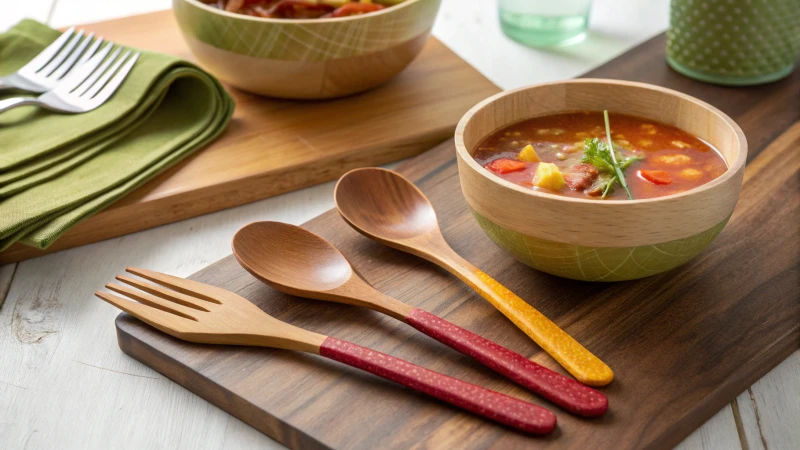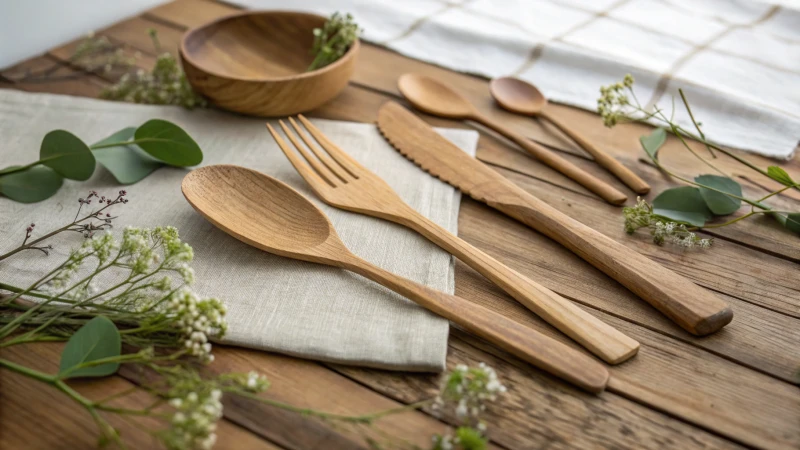
Remember the first time you swapped plastic forks for wooden ones at a picnic? Let's see if they can handle hot soup.
Absolutely, disposable wooden cutlery is up to the task of handling hot beverages and high-temperature foods. These utensils are built tough, so they won’t warp or release harmful chemicals, making them a safe, eco-friendly choice for your steaming cup of coffee or bowl of soup.
I was curious about how my wooden cutlery would fare with hot dishes. I remember when I first tried them with a steaming bowl of soup; they held up without a hitch! Unlike plastic, which can melt or leach chemicals, wooden cutlery remains sturdy and safe. Now, I always keep a stash of them for my tea-loving friends. They’ve become a staple in my quest for sustainability without sacrificing quality or safety. Plus, knowing that I'm reducing plastic waste makes every meal feel like a small victory for the planet.
Wooden cutlery leaches chemicals when used with hot foods.False
Wooden cutlery does not leach chemicals, making it safe for hot use.
Disposable wooden cutlery can handle high temperatures effectively.True
Wooden utensils are robust and suitable for hot beverages and foods.
How Does Wooden Cutlery Perform with Hot Beverages?
Ever sipped a steaming cup of coffee with a wooden spoon? I have, and it's surprisingly pleasant!
Wooden cutlery is perfect for hot beverages due to its low thermal conductivity, keeping your hands safe. It can handle temperatures up to 120°C without breaking down or leaching harmful chemicals, making it an eco-friendly choice.

Thermal Conductivity of Wooden Cutlery
Let me tell you, one of the most surprising things I found when I started using wooden cutlery was how comfortable it felt to hold even when stirring hot drinks. Unlike metal, wood has low thermal conductivity1, so it doesn't burn your fingers. It's like magic—you get all the warmth from your tea or coffee without any discomfort.
Durability and Heat Tolerance
I remember hosting a brunch where I wanted everything to be eco-friendly. I was a bit worried about how the wooden cutlery would handle my hot soup. But after testing, I found that quality wooden utensils maintain their shape and strength up to 120°C, and those with biocoatings2 even withstand higher temperatures! This made me feel more confident about making sustainable choices without compromising on quality.
| Material | Maximum Temperature | Features |
|---|---|---|
| Wood | 120°C | Eco-friendly, low heat transfer |
| Metal | 500°C+ | High heat transfer, durable |
| Plastic | 90°C | Melts easily, potential chemical leach |
Safety and Environmental Benefits
I once read about how plastic cutlery can release harmful chemicals into hot drinks. Since switching to wooden alternatives, I've felt at ease knowing that they don’t pose such risks. Plus, Dynamic Thermal Mechanical Analysis3 shows these utensils remain stable, which reinforces my decision to choose safer, planet-friendly options.
Aesthetic and User Experience
There's something charming about wooden cutlery that adds a rustic vibe to any table setting. Whenever I use them in cafes or at home, they seem to elevate the whole dining experience with their natural look and feel. They also align perfectly with the sustainable ethos many places strive for today.
Exploring Alternatives to Plastic Cutlery
The shift from plastic to wooden cutlery is more than just a trend—it's a necessary change. Many businesses now opt for these eco-friendly options, which speaks volumes about our growing awareness and commitment to sustainability. For more on this shift and why it's important, check out this information4.
Wooden cutlery transfers heat slower than metal.True
Wood's low thermal conductivity prevents quick heat transfer, unlike metal.
Wooden cutlery melts at 90°C like plastic.False
Wood withstands up to 120°C, unlike plastic which melts at 90°C.
Are Wooden Utensils Safe to Use in High Heat?
Have you ever wondered if those charming wooden spoons are safe to use on a sizzling stove? Let's uncover the truth behind their heat resilience and safety.
Wooden utensils are generally safe for cooking, even in high heat. They don't conduct heat well, reducing burn risks. However, prolonged exposure to extreme temperatures or flames may damage them.

I remember the first time I used a wooden spoon in the kitchen—it was a gift from my grandmother. She swore by them, saying they were not only safe but also added a rustic charm to cooking. It made me curious, though. How do these simple tools hold up against the intense heat of my kitchen adventures?
Heat Conductivity of Wooden Utensils
One of the reasons I love wooden utensils is their natural insulating properties. Unlike metal, which heats up so fast it could double as a branding iron, wooden utensils stay surprisingly cool. This insulating quality5 makes them safe to handle, even when I'm hovering over a bubbling pot of stew. I appreciate how they make cooking feel more relaxed and less hazardous.
Potential Damage Under Extreme Heat
But, just like anything cherished, wooden utensils have their limits. My favorite wooden spatula once met its match when I accidentally left it too close to an open flame at a family barbecue. It got a little scorched and cracked—oops! It's a good reminder that while durable, they aren't invincible. They can withstand a lot, but they need a bit of TLC and awareness in high-heat scenarios.
| Condition | Impact on Wooden Utensils |
|---|---|
| Short-term exposure to heat | Generally safe, maintains integrity |
| Direct flame exposure | Risk of charring or burning |
| High-temperature liquids | Safe but should be monitored for cracks |
Maintenance and Hygiene
Beyond just being careful with heat, keeping these utensils clean is key. Wooden spoons have this natural antibacterial vibe, which is awesome compared to plastic options. But they do need some upkeep. I make it a point to wash them with warm soapy water and avoid soaking them—learned that the hard way! And every now and then, I treat them with food-grade mineral oil to keep them looking and feeling fresh.
- Cleaning Tips: Wash with warm soapy water, avoid soaking.
- Oiling: Use food-grade mineral oil to maintain moisture.
By following proper maintenance practices6, I find my wooden utensils last longer and stay hygienic.
Comparison with Other Materials
When it comes to comparing materials, each has its perks. Silicone can take higher temperatures without a sweat but lacks that earthy feel that wood offers. Plus, there's something fulfilling about using tools that are both functional and eco-friendly.
In essence, wooden utensils are champions in maintaining coolness under heat and boast environmental benefits. As long as I treat them right and keep an eye out for extreme conditions, they remain trusty companions in my culinary escapades.
Wooden utensils conduct heat quickly.False
Wooden utensils have insulating properties and do not conduct heat quickly.
Prolonged heat exposure can damage wooden utensils.True
High temperatures can cause wooden utensils to char or crack.
Why Choose Wooden or Plastic Cutlery for Hot Foods?
Ever found yourself at a barbecue, wondering if your fork could handle the heat of a sizzling steak? Let's dive into the wooden vs. plastic cutlery debate.
Wooden cutlery is generally safer for hot foods due to its natural heat resistance and absence of harmful chemicals, unlike some plastics which may leach toxins when exposed to high temperatures.

Heat Resistance
I remember once trying to dig into a steaming bowl of homemade soup with a plastic spoon, only to watch it slowly bend under the heat. That was when I learned firsthand about the importance of heat-resistant utensils. Wooden cutlery is like a dependable friend at a summer picnic—it handles the heat without losing its shape or releasing anything harmful. Unlike some plastic options7, which might buckle or leach toxins when things get too hot.
Environmental Impact
There's something deeply satisfying about knowing your choices have a positive impact. When I switched to wooden cutlery, it wasn't just about avoiding melted plastic in my meals. It was also about contributing to a healthier planet. Wooden utensils, made from sustainable sources, break down naturally, unlike their plastic counterparts that often end up clogging our landfills. While biodegradable plastics8 are an option, they still can't match the minimal environmental footprint of wood.
| Cutlery Type | Heat Resistance | Environmental Impact |
|---|---|---|
| Wooden | High | Low |
| Plastic | Variable | High |
Health Considerations
Health-wise, I can't help but feel safer using wooden cutlery, especially after learning how some plastics can release harmful chemicals when exposed to high heat. It's reassuring to know that with wood, I'm not adding unwanted ingredients to my meals. It's these small changes that make me feel like I'm doing right by my body.
Cost and Convenience
Sure, wooden cutlery might cost a bit more upfront. But considering the long-term benefits like durability and peace of mind, it feels like a wise investment. Plus, who wouldn't want their dining experience to be as safe and sustainable as possible? Meanwhile, plastic utensils are budget-friendly and ubiquitous. But for me, the comfort in knowing I'm making a healthier, eco-conscious choice is worth the little extra.
Choosing between wooden and plastic cutlery for hot foods is like deciding between short-term convenience and long-term benefits. Each has its ups and downs, but with a bit of thought about their properties, I find myself gravitating towards the natural elegance and safety of wood.
Wooden cutlery withstands high temperatures without warping.True
Wood is naturally heat-resistant, making it suitable for hot foods.
Plastic cutlery is more environmentally friendly than wooden.False
Plastic contributes to waste, while wood is biodegradable and sustainable.
Why Choose Wooden Cutlery for Sustainability?
I remember the first time I swapped plastic for wooden cutlery—it felt like such a small change, but it opened my eyes to a more sustainable lifestyle. Here's why more people are making this simple switch.
Wooden cutlery stands out as a sustainable option because it's biodegradable, made from renewable resources, and has a lower carbon footprint than plastic. It naturally decomposes, reducing waste and environmental harm.

Eco-Friendly Materials
Switching to wooden cutlery isn’t just about looking chic at your next picnic; it’s about choosing materials that come from renewable sources like birch or bamboo. I once took a walk through a responsibly managed forest and realized how much care goes into maintaining these resources sustainably. These trees require less energy and water than producing plastics, which aligns perfectly with my goal to reduce my carbon footprint.
Biodegradability and Compostability
The beauty of wooden cutlery is its ability to decompose naturally. I recall visiting a community composting site where they showed how wooden utensils break down within weeks, unlike the plastics that just linger for centuries. Here's a quick comparison:
| Material | Decomposition Time |
|---|---|
| Wood | 3-6 months |
| Plastic | 450+ years |
Lower Carbon Footprint
Imagine making a choice that emits fewer greenhouse gases. That's what happens when you opt for wooden cutlery. The production uses less energy, aligning with global carbon reduction goals. I like to think of each meal as a small step towards a larger, greener planet.
Chemical-Free Production
One of my biggest concerns is the safety of what I use daily. Wooden cutlery is typically free from the harmful chemicals found in plastics. Many manufacturers, including those I trust, avoid using bleaches or dyes, keeping the product natural and safe for both humans and our beloved Earth.
Supporting Sustainable Practices
Every time I choose wooden cutlery, I feel like I'm supporting industries committed to sustainable practices. Businesses can align with suppliers focusing on eco-friendly production, enhancing their brand's sustainability image. It's like being part of a global community dedicated to making thoughtful choices.
By switching to wooden cutlery, I not only support a more sustainable lifestyle but also encourage suppliers to adopt eco-friendly practices, reducing reliance on non-renewable resources. It’s about making every bite count towards a better future.
Wooden cutlery decomposes in 3-6 months.True
Wood decomposes within 3-6 months in compost, unlike plastic.
Plastic cutlery is made from renewable resources.False
Plastic is made from non-renewable petroleum-based materials.
Conclusion
Disposable wooden cutlery is durable and safe for hot foods, withstanding temperatures up to 120°C without leaching harmful chemicals, making it an eco-friendly alternative to plastic.
-
Understanding the thermal properties of wood can help readers grasp why wooden cutlery is safe for hot beverages. ↩
-
Discover how biocoatings enhance the heat resistance of wooden cutlery without harmful effects. ↩
-
Learn about testing methods ensuring wooden cutlery's stability under heat. ↩
-
Explore more about the benefits and trends in replacing plastic with sustainable materials. ↩
-
Understanding why wooden utensils don't conduct heat helps users appreciate their safety benefits in cooking. ↩
-
Proper maintenance ensures longevity and hygiene, making it essential knowledge for wooden utensil users. ↩
-
Learn how high temperatures affect plastic utensils and potential health risks. ↩
-
Understand how different materials impact the environment and sustainability. ↩
-
Learn how renewable resources contribute to long-term environmental health and resource management. ↩
-
Discover the environmental benefits of composting and how it significantly cuts down landfill contributions. ↩
-
Explore why lowering carbon emissions is crucial for combating climate change and promoting sustainability. ↩

